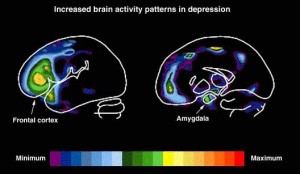http://www.brainviews.com/abFiles/ImgPet.htm
Simon who is a widowed father of age 53 came to the hospital with mentally unstable mind. He had a severe depression to the point of attempting suicide and wasn’t willing to receive the proposed treatment (1). The dilemma is whether physicians should take Simon’s refusal as a respect for his autonomy and not give the proposed treatment of electroconvulsive shock therapy or value beneficence more and give the treatment despite Simon’s will. Specifying a little bit more, we need to focus on and explore if Simon is competent enough to be considered as autonomous and decide the matter for himself.
In Scotland, the government has introduced an interesting bill to be considered supporting physicians to assist their patients with committing suicide should they desire (2). It has complicated issues and questions involved, such as what are patients’ and physicians’ roles, is it moral to help patients to commit suicide, what is physicians’ job ultimately in helping patients, how do we redefine “helping”, how do we balance between patients’ autonomies and physicians’ need to be beneficent, etc. Applying it to Simon’s case, if we value his autonomy, he not only won’t be treated with the electroconvulsive shock therapy but also will most likely to commit suicide. As a result, doctors may be passively “assisting” Simon to commit suicide. Before we go further and look deeper into whether it is morally better for the doctors to value autonomy over beneficence, it is important to specify what constitutes autonomy and if doctors should respect Simon for his autonomy, if he has any.
According to Beauchamp and Childress, there are three components to autonomy: intentionality, understanding, and noncontrol (3). Simon has intentionality; he doesn’t want the treatment. In addition, although there are influences and resistances exerted by the physicians, Simon remains firm and “noncontrolled”. His autonomy is questionable when we consider his understanding of the situation, though. He doesn’t seem to understand his own situation nor the benefits and possible consequences of the electroconvulsive shock therapy due to the severe depression he has. This ties into assessing one’s competence. Appelbaum and Grisso presented the standards of incompetence including inability to understand one’s situation and its consequences (4). Simon may be able to express his own intentions, but whether physicians should respect his autonomy is debatable because of his current mental condition that hinders his understanding of the circumstances. I say doctors should go ahead and give him the treatment.
Now, the consequences of valuing beneficence over autonomy may be costly. Simon may suffer from permanent memory loss and possibly death in the worst case scenario, not to mention the fact that the treatment only temporarily relieves the severe depression. However, I believe physicians should consider the best solution for the patients always, and in this case, it is treating him with the electroconvulsive shock therapy. They should respect patients’ autonomy, but not when a patient is about to commit suicide because of depression or when the patient himself doesn’t really know much about his own state of mind incapable of making a reasonable decision. In fact, the consequence of valuing autonomy over beneficence is much worse, Simon with his severe depression that doesn’t seem to improve with the current medication, which might lead to his suicide. To give or not to give the treatment is the dilemma. Neither way can satisfy every party involved. Therefore, I believe physicians should make the best choice for the patient who doesn’t meet the criteria of autonomy by giving the treatment to prevent Simon from committing suicide.
References:
1. Waluchow, Wilfrid J., and Elisabeth Gedge. “3.2 Non-Consensual Electroconvulsive Shock Therapy.” Well and Good. a Case Study Approach to Health Care Ethics. By John E. 1926- Thomas. Peterborough, Ontario: Broadview, 2014. 124-31. Print.
2. Russell, Paul. “Pro-assisted Suicide Lobby Making Nonsense.” LifeSiteNews. Life Site, 28 Jan. 2015. Web. 29 Jan. 2015. <https://www.lifesitenews.com/opinion/pro-assisted-suicide-lobby-making-nonsense>.
3. Beauchamp, Tom L., and James F. Childress. “Respect for Autonomy.” Principles of Biomedical Ethics. New York, NY: Oxford UP, 2001. 101-40. Print.
4. Paul S. Appelbaum and Thomas Grisso, “Assessing Patients’ Capacities to Consent to Treatment,” New England Journal of Medicine 319 (December 22, 1988)





 Another point the case discussion brought up is the role institutions have on our autonomy. In general, most people are part of institutions, such as schools and workplaces, at some point in their lives. Almost by definition, institutions must provide some types of regulation to ensure that chaos does not occur. However, social institutions that are able to provide individuals with the biggest sense of autonomy are the most successful (
Another point the case discussion brought up is the role institutions have on our autonomy. In general, most people are part of institutions, such as schools and workplaces, at some point in their lives. Almost by definition, institutions must provide some types of regulation to ensure that chaos does not occur. However, social institutions that are able to provide individuals with the biggest sense of autonomy are the most successful ( further supports allowing patients to participate in the study. Indeed, many people who are fully competent and healthy participate in studies so that they can contribute to society. If contributing to society makes these patients feel more fulfilled and happy, then I argue that it is the director’s moral obligation to allow the patients and their family’s to make such a choice.
further supports allowing patients to participate in the study. Indeed, many people who are fully competent and healthy participate in studies so that they can contribute to society. If contributing to society makes these patients feel more fulfilled and happy, then I argue that it is the director’s moral obligation to allow the patients and their family’s to make such a choice.